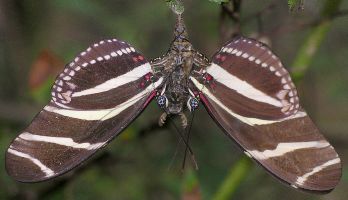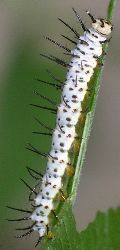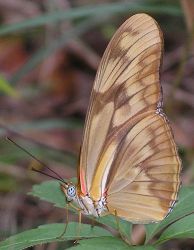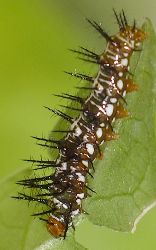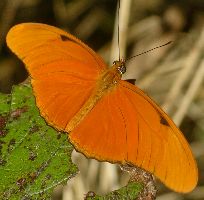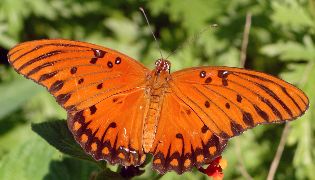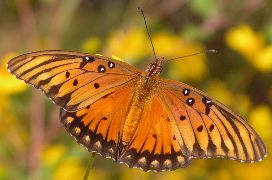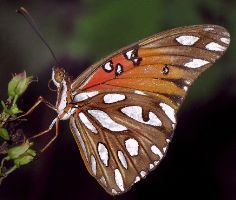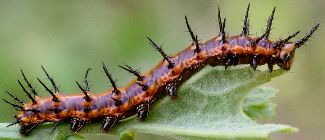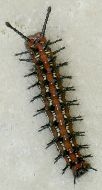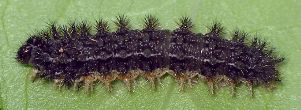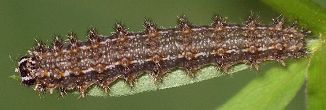
| Nymphalidae ~ Brush-footed Butterflies |
page 1 ![]() page 2
page 2 ![]() page 3
page 3 ![]() page 4
page 4 ![]() page 5
page 5
|
This is a large butterfly family and there is such diversity that few characteristics are universal. The "brush-footed" name refers to the one feature shared by almost all the members of this group. The first pair of legs are modified and reduced in size, no longer being used to support the weight of the resting insect. Although the tiny legs themselves are difficult to see on live butterflies, the fact that the insects appear to have only four legs is a good clue. There are a number of well-defined subfamilies, which used to be considered separate families, and still are by some taxonomists. It doesn't really matter whether they are called families or subfamilies, as the groupings are still the same.
We have three species whose larvae feed on passionflower vines. Perhaps the most distinctive of these is the Zebra Longwing (Heliconius charithonia). It is tropical and only occasionally breeds here in Austin. Some years there are many individuals and other years they are all but absent. The flight of Zebras always appears to be leisurely and slow. They are enchanting. Adult Zebra Longwings live for several months, which is quite long for a butterfly. They are also unusual in feeding on both pollen and nectar instead of just the latter. The larvae ingest toxins from the passionflowers they eat, so the adults are boldly colored with warning marks of black and white. The white stripes are yellow in some populations (especially in Florida), but around here they almost always look practically white. An unusual behavior of these butterflies is their communal roosting for the night. A number, sometimes as many as twenty or more, will all perch together on a single branch to sleep. They hang down and look much like droopy leaves.
Zebras have a well-documented and fascinating way of mating, where the males locate the females while the latter are still in their chrysalises. The male will actually start to mate with the female before she has emerged. In the accompanying photo, the two butterflies both have their abdomens inserted into the pupa. I first thought that it was an emerged female with a male that had found her earlier. However, upon closer inspection, I think it is two males vying for reproductive rights with the female still in the chrysalis. When a chrysalis splits open, it does so at the top of the head, and this one is still intact.
The only other butterfly with such long and narrow wings as the Zebra is the Julia (Dryas julia). It is, however, orange, so there can be no mistaking the identity. While the undersides of the wings are nondescript brown, the upper sides are bright orange. Females have more pronounced dark markings and the orange is often lighter than males. The Julia is not very common in our area, but often strays up from the south during the latter months of the year. Sometimes they do reproduce here in Austin, though, so it is possible to find caterpillars.
Of the three species in our area whose larvae feed on passionflowers, the Zebra is the only one that is white. It has black spines and spots, but is otherwise all white. The Julia caterpillars have white markings, but they are mainly brownish. Their spines are longer, too.
The Gulf Fritillary (Agraulis vanillae) is by far our most common passionflower butterfly. It is orange with black markings on the tops of the wings. Underneath it has silvery white spots. The wings are not as long as the Zebra or Julia, but they are noticeably longer than other butterflies. The upper sides of the males' wings are a deep orange color while the females tend to have lighter orange and more black markings. Because Gulf Fritillaries breed through much of the year, it is easy to see that those developing during warm weather are much larger than those that mature in cold temperatures.
The pupae of the Gulf Fritillary hang down with the tail attached to something hard. They vary in color but are usually shades of brown and gray. The abdomen end of the pupa is quite flexible and can move the chrysalis back and forth to help with temperature regulation. On cold days they try to maximize exposure to the sun. The chrysalis of the Zebra is spinier and has much longer "horns" on the head than the Gulf Fritillary. The accompanying image shows a Zebra pupa that has just molted, hence the yellow color. It will darken as the outer skin hardens. Both eggs and caterpillars of the Gulf Fritillary are frequently encountered, especially by gardeners who grow passionflowers. The eggs are laid singly, usually on a tendril or bud tip. They are elongated and yellow, with many little rows of bumps on them. They remind me of tiny squished ears of corn.
The caterpillars are usually purple and orange, with black spines. Sometimes they have white spots. If one examines the spines closely, it can be seen that they are not just single spikes but are branched. This is common on many nymphalid butterfly larvae. There is one other moderately common species related to the Gulf Fritillary and that is the Variegated Fritillary (Euptoieta claudia). This is a tan, brown, and orange butterfly with a complex checkered pattern and dark dots. It looks similar to some crescents but is larger, being a medium-sized butterfly. The caterpillars feed on a variety of plants, including passionflower, flax, and other garden flowers. They are orange with white markings, black branched spines, and a pair of long spines over the head.
Another distinctive group of nymphalids includes the crescents, patches and checkerspots. These are all rather small with complex patterns usually including orange and black. They have rounded wings. The caterpillars of this group are all similar, with bands of closely packed branched spines. The crescent larvae are small while those of patches are proportionately larger. As early instars, the larvae feed together, sometimes with a bit of webbing around them. They later wander off individually as they get larger. Texan Crescent (Phyciodes texana) caterpillars are dark on top with tan sides. They feed on plants in the acanthus family. The Phaon Crescent (Phyciodes phaon) larvae feed on Frogfruit (Phyla incisa), a low-growing ground cover in the verbena family. The larvae are brown or even light colored with dark stripes. The Pearl Crescent (Phyciodes tharos) feeds on asters and is brown with thin white stripes.
The caterpillars of patches are larger than crescents, as are the butterflies. The Bordered Patch (Chlosyne lacinia) caterpillars come in three main color forms, with intermediates as well. One is almost solid orange with a bit of black, another is black with orange down the back, and the last is all black. Sometimes whole groups will be one color or they can be mixed. They feed on plants in the compositae family, especially sunflowers. The Crimson Patch (Chlosyne janais) has very uniform caterpillars that are always white with black bands. The head is orange. In our area they prefer to feed on Flame Acanthus (Anisacanthus wrightii) and sometimes spend the winter at the base of the plants. I've seen mature caterpillars waiting on the stems of Flame Acanthus for the first sprouts in the late winter. |
page 1 ![]() page 2
page 2 ![]() page 3
page 3 ![]() page 4
page 4 ![]() page 5
page 5
![]()

